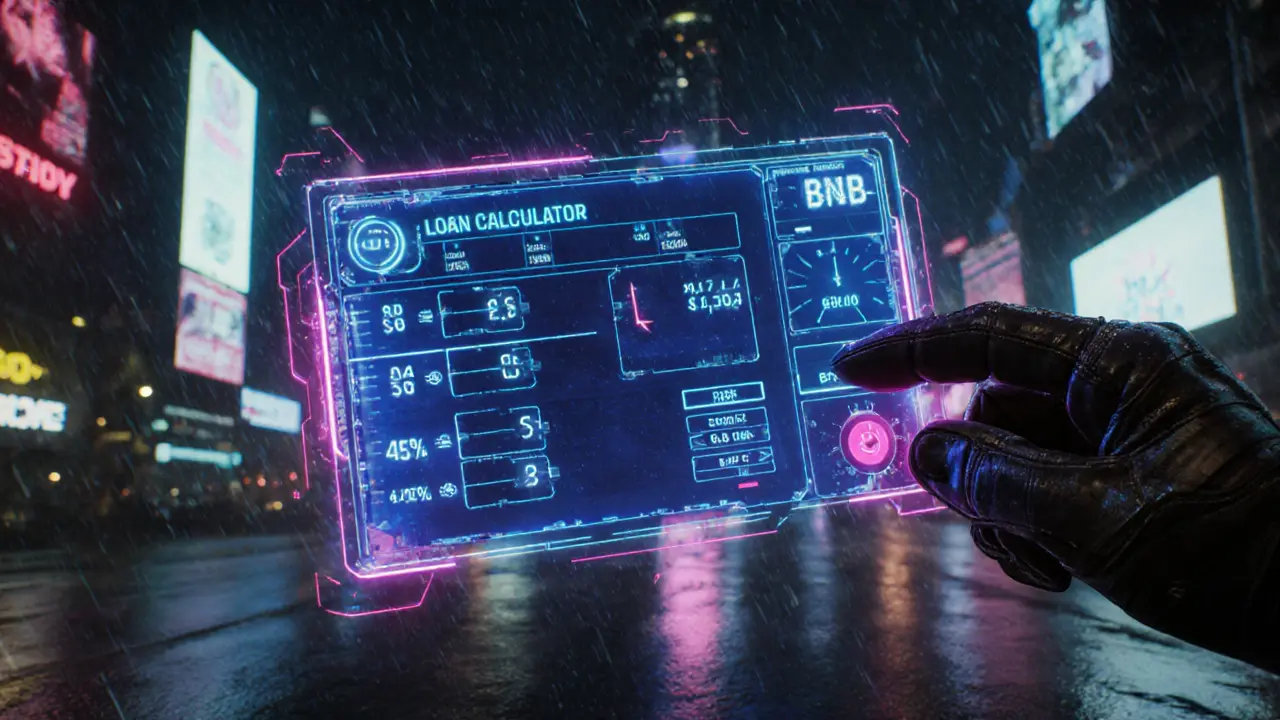Piggy Finance Loan Calculator
Loan Parameters
Loan Summary
Total Collateral Value: $0.00
Maximum Borrowable Amount: $0.00
Current Loan-to-Value Ratio: 0.00%
Liquidation Threshold: $0.00
Risk Level: Low
Recommended Action: None
Key Takeaways
- Piggy Finance is a BNB Smart Chain‑based borrowing protocol that offers interest‑free, BNB‑backed loans.
- The protocol replaces auction‑style liquidations with a Stability Pool that lets users earn PIGGY rewards.
- Two native tokens power the system: $PUSD (a dollar‑pegged stablecoin) and $PIGGY (governance & reward token).
- Minimum collateral ratio is 110%, lower than many competitors but comes with higher liquidation risk.
- Market activity is extremely low - price below $0.001 and daily volume near zero - making the token a high‑risk speculative asset.
Piggy Finance is a decentralized borrowing protocol built on the BNB Smart Chain. It offers interest‑free loans backed by Binance Coin (BNB) and uses a unique Stability Pool to handle liquidations. Launched in 2021, the platform aims to improve capital efficiency compared with traditional DeFi lenders like MakerDAO or Compound.
How Piggy Finance Works
Borrowers deposit BNB as collateral and receive $PUSD stablecoins. The loan stays healthy as long as the collateral value stays at least 110% of the borrowed $PUSD amount. If the price of BNB falls below that threshold, the protocol triggers a liquidation.
Instead of auctioning the seized BNB, the system pulls from the Stability Pool. Users who have deposited $PUSD into the pool become Stability Providers. When a liquidation occurs, a proportionate share of the BNB collateral is transferred to the pool participants, while their $PUSD balance is reduced. Over time, providers accumulate BNB and earn $PIGGY rewards for taking on the liquidation risk.
Tokenomics: $PIGGY and $PUSD
The protocol relies on two tokens:
- $PUSD - a 1:1 USD‑pegged stablecoin used for borrowing and as the liquidity source for the Stability Pool.
- $PIGGY - the governance and reward token. Total supply is capped at 100million.
Staking $PIGGY lets holders claim a slice of protocol fees generated from loan originations and $PUSD redemptions. In a future DAO, $PIGGY holders will vote on parameter changes such as collateral ratios, fee structures, and new asset support.
Stability Pool Mechanics
The Stability Pool is the heart of Piggy Finance’s liquidation model. Here’s a quick step‑by‑step:
- Deposit $PUSD into the pool.
- Earn $PIGGY rewards at a rate that adjusts based on the pool’s total size and ongoing liquidations.
- If a borrower’s collateral falls below 110%, the protocol converts a portion of the liquidated BNB into $PUSD and distributes it to the pool proportionally.
- Your $PUSD balance shrinks while your BNB balance grows, effectively swapping risk for reward.
This method avoids the price‑impact of auction sales and keeps capital circulating within the protocol.

Market Performance & Trading Options
At its peak (Nov22021) $PIGGY reached $0.0284. As of October2025 the price hovers around $0.00029 - a 99% drop. The token has a market cap of roughly $29k, zero reported circulating supply, and virtually no 24‑hour trading volume. Listed on Binance’s Web3 Wallet DEX, on Coinbase for price tracking, and on a few niche DEXes on BNB Smart Chain and Avalanche, liquidity remains thin.
Because of the low volume, price slippage can be severe. Traders should only allocate a small portion of a diversified portfolio and be prepared for large swings.
Pros and Cons
| Feature | Piggy Finance | MakerDAO | Aave |
|---|---|---|---|
| Primary Collateral | BNB (on BNB Smart Chain) | ETH, others | Multi‑asset |
| Min Collateral Ratio | 110% | 150% | varies (typically 115‑150%) |
| Liquidation Method | Stability Pool (no auction) | Auction | Liquidation bots + auction |
| Governance Token | $PIGGY | MKR | AAVE |
| Liquidity (24‑h volume) | ~$0 | Millions | Millions |
Pros:
- Low collateral requirement (110%) enables higher leverage.
- Stability Pool reduces price impact during liquidations.
- Interest‑free loans can be attractive for short‑term needs.
Cons:
- Extremely low market liquidity - hard to buy/sell $PIGGY.
- Zero circulating supply reported by major trackers raises distribution concerns.
- Limited community activity and unclear development roadmap.
- Higher liquidation risk due to aggressive collateral ratio.
Getting Started: Borrower and Stability Provider Walkthrough
Both roles require a compatible wallet (e.g., MetaMask set to BNB Smart Chain) and some BNB to cover collateral.
Borrower Steps
- Connect your wallet to the Piggy Finance web UI.
- Deposit BNB as collateral. The interface will show the maximum $PUSD you can borrow based on the 110% ratio.
- Confirm the loan. You receive $PUSD instantly in your wallet.
- Monitor the BNB price; if it approaches the liquidation threshold, either add more BNB or repay part of the $PUSD loan.
Stability Provider Steps
- Obtain $PUSD - you can mint it by borrowing against BNB or acquire it on a DEX.
- Navigate to the “Stability Pool” tab and deposit your $PUSD.
- Stake any $PIGGY you hold to boost your reward rate.
- When a liquidation occurs, watch your $PUSD balance shrink and your BNB & $PIGGY balances grow.
- Withdraw at any time, keeping in mind that withdrawals may be subject to a small fee.
Both actions are gas‑free on BNB Smart Chain, but you’ll still pay the standard BNB network fee.
Future Outlook
Because development updates are scarce, the long‑term viability of Piggy Finance is uncertain. The protocol’s core innovation - the Stability Pool - remains technically sound, but without active marketing, liquidity incentives, or a vibrant DAO, the token is unlikely to regain significant market share. If the team releases a multi‑chain version (e.g., on Avalanche) and launches strong yield farming campaigns, it could attract a niche audience of high‑leverage traders. Until then, the project sits in the low‑tier segment of DeFi lending.
Frequently Asked Questions
What is the main purpose of Piggy Finance?
Piggy Finance provides interest‑free, BNB‑backed loans on the BNB Smart Chain while using a Stability Pool to handle liquidations in a capital‑efficient way.
How does the Stability Pool differ from auction liquidations?
Instead of selling collateral at a discount through an auction, the protocol distributes the seized BNB directly to $PUSD depositors. This avoids price slippage and lets providers earn BNB plus $PIGGY rewards.
Can I earn $PIGGY without providing stability liquidity?
Yes. By staking $PIGGY in the protocol’s governance module you receive a share of the fee pool, even if you don’t deposit $PUSD.
What are the risks of borrowing on Piggy Finance?
The primary risk is liquidation if BNB price drops below the 110% threshold. Because the protocol uses a Stability Pool, you could lose part of your $PUSD deposit during a liquidation event.
Is $PIGGY listed on major exchanges?
$PIGGY is accessible via Binance’s Web3 Wallet DEX and appears on Coinbase for price tracking, but liquidity is very low and it isn’t available on large centralized exchanges.






Comments
25 Comments
Cody Harrington
Looks like Piggy Finance tries to be the low‑collateral DeFi lender. The Stability Pool idea is interesting, but the thin liquidity worries me. Keep an eye on the $PIGGY price if you plan to stake.
Emily Pelton
Great breakdown, but let’s be real-this thing is a ticking time bomb, and you need to understand the risks before diving in!!! The Stability Pool sounds slick, yet the near‑zero volume makes any exit a nightmare, so only allocate a sliver of your capital. Also, remember to monitor BNB price constantly; otherwise you’ll get liquidated faster than you can say “piggy bank”!
sandi khardani
The architecture of Piggy Finance is a textbook case of over‑engineering in a market that rewards simplicity.
By leveraging a Stability Pool they claim to avoid the price impact of auction liquidations, yet they provide no empirical data to substantiate this claim.
The mandatory 110% collateral ratio, while advertised as low, actually inflates the leverage ratio to dangerous levels when BNB volatility spikes.
Moreover, the dual‑token system of $PUSD and $PIGGY introduces an additional layer of systemic risk that most users fail to comprehend.
The governance token $PIGGY is capped at 100 million, but with a market cap of only a few tens of thousands dollars, any substantial token sale would instantly dilute value.
Historical price data shows a 99% decline since its peak, indicating an almost complete loss of confidence among investors.
The protocol’s reliance on Binance Smart Chain for low fees is moot when the token’s liquidity is effectively zero, rendering swaps impractical.
In practice, the Stability Pool could become a sinkhole if too many borrowers get liquidated simultaneously, exhausting $PUSD reserves.
The reward mechanism for Stability Providers is vaguely defined; without transparent emission schedules, participants cannot gauge expected returns.
The lack of a clear roadmap or active development updates further compounds the perception of abandonment.
Compared to established platforms like MakerDAO or Aave, Piggy Finance offers no competitive advantage beyond an obscure liquidation model.
The protocol’s documentation is riddled with typographical errors and broken JavaScript snippets, suggesting a lack of rigorous testing.
Security audits appear to be either unpublished or performed by unknown auditors, raising concerns about potential vulnerabilities.
For a borrower seeking interest‑free loans, the hidden costs of potential liquidation and illiquid token exposure may outweigh any perceived benefit.
In sum, Piggy Finance’s current state resembles a speculative experiment rather than a mature financial service, and prudent investors should steer clear.
Donald Barrett
If you think this is a clever hack, you’re seriously out of touch.
Christina Norberto
Piggy Finance constitutes a decentralized borrowing protocol predicated upon collateralization of Binance Coin. Its operational paradigm employs a Stability Pool to supplant conventional auction mechanisms, thereby ostensibly mitigating adverse price impact. Nevertheless, the paucity of liquidity and the negligible market capitalization of the governance token engender considerable systemic risk. It is incumbent upon prospective participants to undertake rigorous due diligence prior to engagement.
Fiona Chow
Oh sure, because what the DeFi world really needed was another under‑collateralized loan platform with a token that's basically a ghost.
Rebecca Stowe
Even with the risks, the concept shows promise, and a small, disciplined allocation could be an interesting experiment.
Aditya Raj Gontia
From a protocol engineering perspective, the Stability Pool architecture leverages a collateralized debt position model with an auxiliary liquidity buffer.
Kailey Shelton
Sounds technically sound, but real‑world adoption hinges on UI/UX simplicity.
Angela Yeager
If you decide to try Piggy, make sure to set a low liquidation threshold in your wallet alerts so you can top up collateral before anything nasty happens.
vipin kumar
I can’t shake the feeling that the sudden drop in $PIGGY price was engineered by some hidden hand to flush out early investors.
Lara Cocchetti
Honestly, falling for a token with sub‑cent pricing is a sign of poor judgment; anyone with a modicum of financial sense would avoid it.
Mark Briggs
Wow another DeFi gem lol.
mannu kumar rajpoot
The community's silence speaks louder than any roadmap – if there were real ambition, you'd see active development chatter.
Karl Livingston
I get that the vibe feels stale, but maybe a few dedicated devs are just working behind the scenes; hope they surface soon.
Kyle Hidding
This protocol is a textbook case of liquidity black‑hole syndrome, essentially a Ponzi‑ish construct wrapped in jargon.
Andrea Tan
Just a heads‑up, always keep some BNB handy to cover gas, even if the platform claims gas‑free transactions.
Gaurav Gautam
Stay curious, experiment with small amounts, and you might discover a niche yield strategy nobody else is exploiting.
Robert Eliason
People think it’s a dead project but i bet it’ll bounce back tough.
Chris Hayes
While the token's market cap is miniscule, the underlying Stability Pool concept could be refined and adopted elsewhere if the team commits to transparency.
victor white
One must appreciate the theoretical elegance of a non‑auction liquidation mechanism, even if its practical deployment remains embryonic.
mark gray
In short, if you value capital efficiency and can tolerate high risk, Piggy might fit a tiny portion of your portfolio.
Tilly Fluf
We wish the developers success in revitalizing the ecosystem and hope that future updates will enhance token liquidity and user engagement.
Darren R.
Oh my god!!! Can you believe a project with zero volume is still being marketed as the next big thing??? It’s almost comedic!!!
Hardik Kanzariya
Give it a try, share your results, and let’s discuss what works and what doesn’t in the comments!
Write a comment